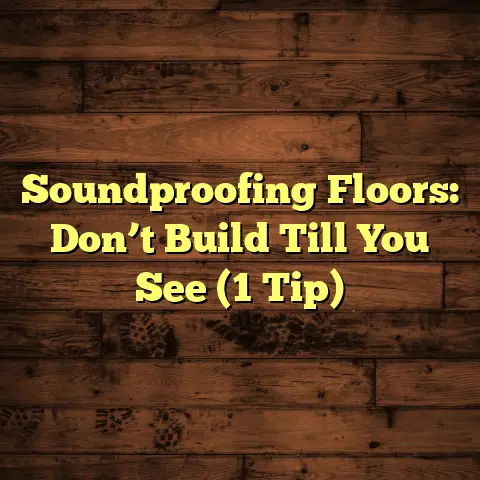Bathroom Vinyl: Best Underlay? (3 Top Options!)
I’m your friendly neighborhood flooring contractor, and today, we’re diving deep into the often-overlooked, but absolutely crucial, world of underlayment for bathroom vinyl flooring.
Choosing the right flooring for your bathroom can
feel like navigating a minefield.
You want something
that looks great, is easy to clean, and, most
importantly, can handle the moisture.
Vinyl flooring has become a go-to for many, and for
good reason.
But here’s a little secret: the
underlay you choose is just as important as the vinyl
itself.
Trust me, I’ve seen it all.
Introduction: The Challenge of Choosing the Right Underlay for Bathroom Vinyl Flooring
Bathrooms.
We love them, we need them, but man,
they can be tough on flooring.
All that water, the
temperature fluctuations from hot showers, and the
constant foot traffic – it’s a recipe for disaster if
you’re not careful.
Vinyl flooring is fantastic because it’s water- resistant and comes in a ton of styles.
But think of the underlay as the unsung hero beneath
the surface.
It’s the foundation that can make or
break your bathroom flooring experience.
Choose the wrong one, and you could be dealing with mold, uneven surfaces, and a vinyl floor that wears out way too soon.
That’s why I’m here to walk you through the best
underlay options for bathroom vinyl.
We’ll explore
three top contenders that can help you achieve the
perfect balance of comfort, durability, and moisture
resistance.
Ready to get started? Let’s dive in!
Section 1: Understanding the Importance of Underlay
for Bathroom Vinyl Flooring
So, what exactly is underlay, and why should you care?
Simply put, underlay is a layer of material installed between the subfloor (the structural floor beneath) and the finished flooring (in this case, your vinyl).
Think of it as a cushion or a buffer.
Its primary role is to provide a smooth, even surface for the vinyl, but it does so much more.
The Role of Underlay in Flooring
Underlay acts as a shock absorber, reducing wear and
tear on the vinyl.
It can also provide sound
insulation, making your bathroom quieter.
And, perhaps most importantly in a bathroom, it can offer a barrier against moisture.
Bathroom Challenges
Bathrooms are unique environments. They’re subject to:
- High Humidity: Showers and baths create a lot of moisture.
- Temperature Swings: From chilly mornings to steamy showers, the temperature fluctuates wildly.
- Foot Traffic: Bathrooms see a lot of action, especially in busy households.
These factors can wreak havoc on flooring if you’re not prepared.
How Underlay Enhances Vinyl Performance
A good underlay can:
- Improve Comfort: Adds a layer of cushioning underfoot.
- Prolong Flooring Life: Reduces stress on the vinyl, preventing cracks and wear.
- Enhance Moisture Resistance: Provides an additional barrier against water damage.
- Improve Sound Insulation: Reduces noise transfer, making your bathroom quieter.
Without the right underlay, you’re basically setting your vinyl flooring up for failure.
I’ve seen countless bathrooms where the vinyl looked
great initially, but quickly deteriorated due to
moisture seeping through or an uneven subfloor.
Don’t
let that happen to you!
Section 2: Criteria for Choosing the Best Underlay
Okay, so you’re convinced that underlay is important.
Great!
But how do you choose the right one?
Here are the key factors to consider when selecting an underlay for your bathroom vinyl:
Key Factors
Moisture Resistance: This is non-negotiable.
You need an underlay that can withstand the humid environment of a bathroom.
Look for closed-cell materials that don’t absorb water.Sound Insulation: If you want a quieter bathroom, choose an underlay with good sound absorption properties.
This is especially important if you have kids or live in an apartment.-
Cushioning: A little extra cushioning can make a big difference in comfort, especially if you spend a lot of time standing in the bathroom.
-
Thermal Properties: Some underlays provide additional insulation, which can help keep your bathroom warmer in the winter.
-
Subfloor Compatibility: Consider the type of subfloor you have (concrete, wood, etc.) and choose an underlay that’s compatible.
Compatibility with Vinyl Flooring Types
Vinyl flooring comes in different forms, and the underlay you choose should be compatible with your specific type:
Click-Lock (Floating) Vinyl: This type of vinyl “floats” over the underlay and doesn’t require adhesive.
Look for underlays specifically designed for floating floors.Glue-Down Vinyl: This type is glued directly to the subfloor.
The underlay should provide a suitable surface for the adhesive to bond to.
Manufacturer Recommendations and Warranties
Always, always follow the vinyl flooring manufacturer’s recommendations for underlay.
Using the wrong underlay can void your warranty.
Check the warranty information carefully before making your decision.
I once had a client who ignored the manufacturer’s recommendations and used a cheap underlay.
Within a year, their vinyl started buckling and
peeling.
They ended up having to replace the entire
floor, costing them way more in the long run.
Learn
from their mistake!
Section 3: Top 3 Underlay Options for Bathroom
Vinyl Flooring
Alright, let’s get to the good stuff.
Here are my
top three underlay recommendations for bathroom vinyl
flooring:
1. Foam Underlay
Composition and Characteristics: Foam underlay is typically made from polyethylene or polyurethane foam.
It’s lightweight, affordable, and easy to install.Moisture Resistance: Most foam underlays have a closed-cell structure, which makes them water- resistant.
However, some cheaper options may not be as effective.-
Cushioning Properties: Foam provides good cushioning underfoot, making it a comfortable choice for bathrooms.
-
Sound Absorption: Foam underlay offers moderate sound absorption, reducing noise transfer to some extent.
-
Benefits:
- Affordable
- Easy to install
- Provides good cushioning
-
Drawbacks:
- May not be as durable as other options
- Can compress over time
- Lower-quality foams may not be very moisture- resistant
-
Recommended Products:
- Roberts Super Felt Premium Underlayment: A good all-around option for vinyl flooring.
- QuietWalk Plus Underlayment: Offers enhanced moisture and sound protection.
2. Cork Underlay
Natural Properties: Cork is a natural, sustainable material made from the bark of cork oak trees.
It’s naturally water-resistant, antimicrobial, and hypoallergenic.-
Moisture Resistance: Cork is naturally water- resistant due to its cellular structure.
-
Thermal Insulation: Cork provides excellent thermal insulation, helping to keep your bathroom warmer.
-
Sustainability: Cork is a renewable resource, making it an eco-friendly choice.
-
Benefits:
- Excellent moisture resistance
- Good thermal insulation
- Eco-friendly
- Naturally antimicrobial
-
Drawbacks:
- Can be more expensive than foam
- Requires proper sealing to prevent mold growth in very damp environments.
-
Recommended Products:
- Amorim Cork Underlayment: A high-quality cork underlay with excellent moisture resistance.
- MP Global Products Insul-Cork Underlayment: Provides great thermal and acoustic insulation.
Here’s a table summarizing the properties of cork underlay:
Source: Cork Quality Council
3. Rubber Underlay
Durable and Versatile: Rubber underlay is made from recycled rubber or synthetic rubber.
It’s extremely durable, resilient, and offers excellent sound insulation.-
Superior Moisture Resistance: Rubber is inherently waterproof, making it an excellent choice for bathrooms.
-
Sound Insulation: Rubber provides superior sound insulation, reducing noise transfer more effectively than foam or cork.
-
Durability: Rubber is highly resistant to compression and wear, ensuring long-lasting performance.
-
Benefits:
- Superior moisture resistance
- Excellent sound insulation
- Highly durable
-
Drawbacks:
- Can be more expensive than foam or cork
- May have a slight rubber odor initially
- Can be heavier and more difficult to install
-
Recommended Products:
- Regupol SonusCurve Underlayment: A premium rubber underlay with exceptional sound and moisture protection.
- Eco-Grip Recycled Rubber Underlayment: An eco-friendly option made from recycled tires.
Here’s a comparison table of the three underlay options:
Section 4: Installation Tips for Underlay and
Vinyl Flooring in Bathrooms
Okay, you’ve chosen your underlay.
Now it’s time to
install it!
Here’s a step-by-step guide to help you
get the job done right:
Step-by-Step Guide
Prepare the Subfloor: This is crucial.
Make sure the subfloor is clean, dry, and level.
Remove any debris, nails, or staples.
If the subfloor is uneven, use a leveling compound to create a smooth surface.-
Measure and Cut the Underlay: Measure the bathroom floor and cut the underlay to fit, leaving a small gap (about 1/4 inch) around the perimeter of the room for expansion.
Install the Underlay: Roll out the underlay and secure it to the subfloor using manufacturer- recommended adhesive or tape.
Overlap the seams slightly and tape them together to prevent moisture from seeping through.Install the Vinyl Flooring: Follow the manufacturer’s instructions for installing your vinyl flooring.
If you’re using click-lock vinyl, simply snap the planks or tiles together.
If you’re using glue-down vinyl, apply adhesive to the underlay and carefully position the vinyl tiles or sheets.-
Finishing Touches: Install baseboards or quarter-round molding around the perimeter of the room to cover the expansion gap and give the floor a finished look.
Essential Tools and Materials
- Measuring tape
- Utility knife
- Straight edge
- Adhesive or tape (as recommended by the manufacturer)
- Leveling compound (if needed)
- Baseboards or quarter-round molding
- Safety glasses and gloves
Tips for Preparing the Subfloor
- Clean Thoroughly: Use a vacuum cleaner and a damp mop to remove all dirt and debris.
- Check for Moisture: Use a moisture meter to
check the moisture content of the subfloor.
It should be below the manufacturer’s recommended level. - Repair Cracks and Holes: Fill any cracks or holes with a patching compound.
- Level the Surface: Use a leveling compound to create a smooth, even surface.
Ensuring a Smooth Finish
- Use a Roller: After installing the vinyl, use a floor roller to ensure that it’s properly bonded to the underlay.
- Check for Gaps: Inspect the floor for any gaps or uneven seams and correct them as needed.
- Allow Time to Acclimate: Before using the bathroom, allow the vinyl flooring to acclimate to the room’s temperature and humidity for at least 24 hours.
I can’t stress enough how important proper
installation is.
Even the best underlay won’t perform
well if it’s not installed correctly.
If you’re not
comfortable doing it yourself, hire a professional.
It’s worth the investment to ensure a long-lasting,
beautiful bathroom floor.
Section 5: Conclusion
So, there you have it!
Choosing the right underlay for
your bathroom vinyl flooring is a critical decision
that can impact the comfort, durability, and longevity
of your floor.
Recap
We’ve covered a lot of ground today, from understanding the importance of underlay to exploring the top three options: foam, cork, and rubber.
Each has its own strengths and weaknesses, so it’s important to weigh your options carefully and choose the one that best meets your needs.
Benefits of the Top Options
- Foam: Affordable and provides good cushioning.
- Cork: Eco-friendly and offers excellent moisture and thermal insulation.
- Rubber: Superior moisture resistance and sound insulation.
Consider Your Needs and Preferences
Ultimately, the best underlay for your bathroom vinyl flooring depends on your specific circumstances, budget, and preferences.
Consider factors like moisture levels, sound insulation needs, and desired level of comfort when making your decision.
And don’t forget to follow the manufacturer’s recommendations for both the vinyl flooring and the underlay.
I hope this article has helped you navigate the world of bathroom vinyl underlay and given you the confidence to make the right choice for your home.
Happy flooring!





